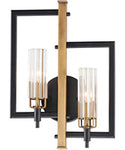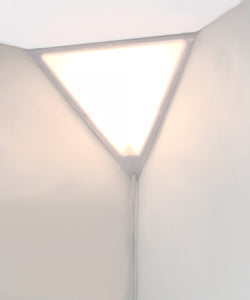
How to Choose Guest Room Lighting
Search
Main Article: How to Choose the Right Light Fixtures for Your Room
The Purpose of a Guest Room
A guest room is a medium-sized room, similar to a bedroom, designed to support guests and family who want to spend the night. It features an often larger comfortable bed, temporary storage for clothing, perhaps a comfortable chair and even a television.
It's useful to model your guest room after a hotel room, including entertainment, refreshments, a possible refrigerator, coffee maker, hairdryer etc, helping to make an overnight or extended stay more convenient. Install a mirror to aid in dressing, consider extra heating and cooling, and perhaps add a desk with a desk lamp for practical uses.
The Lighting you'll need in a Guest Room
The guest room features a compact range of facilities, almost like a miniature home in itself. The bed is the main feature, accompanied by lighting, lamps, basic furniture, seating and storage for clothing or luggage. The guest room will be used in a similar manner to a bedroom. Adapting your lighting choices to how people will use the room is important.
- Overhead ceiling lights are important for lighting up a guest room. A ceiling light is ideally placed over the bed if possible, or at least near the center of the room.
- Chandeliers and pendants can be mounted as ceiling lights, provided you have enough headroom. You'll need either higher ceilings or place the fixtures over the bed. Small pendants or small chandeliers can be hung over bedside tables.
- Semi-flush or flush-mounted lights mount close to the ceiling and give ample headroom below. One or two fixtures mounted fairly centrally should provide strong overhead lighting. These light fixtures are small enough that they leave plenty of room below for a person to walk.
- Recessed "pot" lights can be recessed into the ceiling. They take up no room height and give a modern look. Each shines a single light bulb downwards so you'll need to install several across the ceiling to light the whole guest room.
- Wall sconces can be added to the guest room walls, especially near doors, behind seating areas or at the sides of the bed. They can be used to create a softer ambient mood or used along with other light fixtures. If the wall lights include a switch which can be operated from the bed, all the better.
- Portable lamps such as table lamps, floor lamps and reading lamps place light at an ideal height for sitting, reading and relaxing. Ideal next to or behind seating or sleeping areas, they can be switched on and off independently from the main lighting. Table lamps work well on bedside tables or in the corners of the room. Floor lamps are ideal next to a comfortable chair.
- Use a desk lamp if you have a desk area. A desk can be useful for a guest which is why most hotel rooms include a desk. A desk lamp shines light down onto the desk surface to help with reading and writing. Also consider buffet lamps if you have a narrow side table or buffet.
- Add a ceiling fan to help with ventilation, heating and cooling. Placing the fan over the bed allows the residents to enjoy a cool breeze in the summer heat. Some fans also include light fixtures so can act as a central light. Place the fan over the bed, or otherwise make sure there is enough room to walk below.
- Accent lighting can be added. For example spot lights can shine focused light in a specific direction, to e.g. light up a piece of wall art or furniture. Accent lamps can add decorative touches of gentle light. And can lights can give an interesting upward-pointing light, mounted on the floor. Add a night light to help your guests find their way in the dark, and if you have a separate powder room or guest bathroom, place one there, as well as in any hallway between.

The use of Lighting in your Guest Room
The main function of your lighting should be to help people to see in the dark, especially in the evening and at night. Since the guest room is a multi-functional, practical room, ensure there is a bright main light as well as a softer secondary light such as lamps for a more relaxed atmosphere.
Also consider where in the room people will spend the most time and what they will be doing there. Will they be sitting in certain areas? Laying down? Moving around? Needing to read or write or work in detail? Will they be focusing on things close to themselves or at a distance?
- Ambient Lighting is when the light is bright and spreads out in generally all directions, lighting up most of the room. Ambient light can also be background light. It is less focused and more diffused. Ceiling lights and wall lights can create ambient lighting.
- Task Lighting is when the light is more focused into a smaller area, possibly aimed in its direction, and is used when performing tasks. Such as when reading a book or applying makeup, you'll need light fixtures or lamps nearby so that you can see what you're doing.
- Accent Lighting comes from small accents of light generally in the background. This are the finishing touches such as small novelty lamps, can lights, spot lights, accent lamps and other decorative lighting. The amount of light output is usually less and limited to a smaller area. A night light is also useful for a guest room.

Where to put Lighting in a Guest Room
Main Light Fixtures
In a guest room you'll likely want one or two main light fixtures, positioned fairly centrally in the room. These could be chandeliers, pendant lights, semi-flush mount lights, flush-mount lighting, or ceiling fans with lights. Ensure there is enough room below the light fixture.
With a bed in the room, it's useful to put the light above the bed to take advantage of the unused floor space. Another popular lighting idea for a guest room is to hang pendant lights over side tables or nightstands, either side of the bed. If there is room for a small table or desk, consider a small chandelier over it.
If the room is longer than square, consider breaking it up into sections like separate rectangles, with one light in the center of each. Centrally positioned lights will emit light in all directions and light up most of the room.
Secondary Light Fixtures
To complement the main light fixture and provide additional layers and levels of light, adding a couple of wall sconces on a wall near to seating can be useful. Small pendants can hang over nightstands, desks or dressers. Also swing-arm wall lights work well next to the bed and can be moved into different positions.
Also consider floor lamps, torchieres or reading lamps. These give off brighter light than other lamps and work well next to a chair or in the corner of a guest room. Another option is a hotel lamp which features electrical outlets, chargers and ports built into the lamp to help with charging and using electronic devices, including shavers, hairdryers, clocks etc.
Task Light Fixtures
Often in a guest room you'll see table lamps, which work well positioned next to the bed. The local light can help with tasks such as reading in bed. An alternative is a reading lamp, which is a type of floor lamp designed to help with reading. Another option for the bedside is a pendant light fixture.
If you have other small areas which occasionally need bright light, such as a dresser or desk, consider a desk lamp or a floor lamp nearby. Table lamps also work well at the sides of a room as more of a background light for a more relaxed mood with less brightness.
Consider eyesight and glare
When placing lighting in a guest room, remember that light comes from a light bulb in most cases. The light may or may not be covered in all directions. For example, a light over the bed will need to have a covered shade to avoid glare when laying down. This is why table lamps or pendants with shades beside the bed are a good idea because they shield the eyes from glare.
Think about what direction the light will shine and what the line of sight will be. You might benefit from an overhead light when needed, but you may not want it shining in your face when laying in bed.

How much Lighting does your Guest Room need?
The amount of light needed in a guest room is usually at a high level compared to other rooms. Also the size of the room and the natural lighting coming in through windows will affect the amount of light needed.
Light is best measured in lumens, which is a measure of how much light reaches a surface at a given distance. In general it means "brightness" in a standardized way. You'll need to calculate an idea of how much light you want in the room, and then try to aim to achieve this across your light fixtures and lamps.
A general approach is as follows:
- Measure the length and width of the room in feet..
- Multiply the two numbers to get the "square feet".
- Multiply the square feet by the amount of lumens needed per square foot for the room - for a guest room this is 70-80 lumens per square foot.
For example in an 11 x 12 foot guest room:
- 11 x 12 = 132square feet.
- 132 x 70 = 9240 total lumens on the low end.
- 132 x 80 = 10560 lumens on the high end.
In terms of light bulbs: A single 60-watt incandescent light bulb outputs about 800 lumens. If you were using purely 60-watt bulbs, you'd need at least e.g. 9240 / 800 = 11.5 light bulbs minimally, up to 10560 / 800 = 13.2 bulbs maximally. So roughly 11 to 13 light bulbs at 60 watts each would be needed for a guest room.

Recommended Lighting for a Guest Room
Here are our top picks for types of lighting and light fixtures that would work best in a guest room.
Ceiling Lights
Wall Lights
Lamps

More Rooms to Explore
Shop for Guest Room Lighting
We've curated our light fixtures to save you time.
Shop now by showing only guest room lighting.
Explore Topics

Table of Contents
How to Choose Guest Room LightingThe Purpose of a Guest RoomThe Lighting you'll need in a Guest RoomThe use of Lighting in your Guest RoomWhere to put Lighting in a Guest RoomHow much Lighting does your Guest Room need?Recommended Lighting for a Guest RoomMore Rooms to ExploreShop for Guest Room LightingCommentsShopping Ideas
Trending

































































Comments